When I created iDigHardware in 2009, I never in a million years thought that code officials would read it. But I am so proud to say that I have many readers who are AHJs, and sometimes they even ask me questions. A fire marshal recently asked me today’s Quick Question:
A school district in my jurisdiction wants to use chains and padlocks to secure the school buildings at night and on weekends. Do the model codes allow this when the building is not occupied?
This might seem like a simple question to answer, but there are strong opinions on both sides. Here are my thoughts on this issue:
NFPA 101 differentiates between what is allowed when the building is occupied vs. not occupied, so some AHJs interpret the requirements of the Life Safety Code to apply only when a building is occupied, and not when it is unoccupied. But what often happens is that the chains and padlocks used to secure a building when it is unoccupied, remain in place even when the building IS occupied. I also think about firefighters in an unoccupied building during a fire, unable to exit through chained doors.
I spend most of my time working with the I-Codes – the International Building Code (IBC) and the International Fire Code (IFC). These codes require egress doors to unlatch with one releasing motion, without a key, special knowledge, or effort, and the I-Codes don’t differentiate between occupied/unoccupied with regard to egress. I don’t see anything in the IFC that says egress doors can be locked in the direction of egress when the building is not occupied (with some exceptions related to special locking arrangements).
There are several sections in NFPA 101 and some explanatory information in the Life Safety Code Handbook that I would interpret to mean that chains and padlocks can not be used on a school’s egress doors – even when the building is not occupied:
7.2.1.1.3.2 Where means of egress doors are locked in a building that is not considered occupied, occupants shall not be locked beyond their control in buildings or building spaces, except for lockups in accordance with 22.4.5 and 23.4.5, detention and correctional occupancies, and health care occupancies.
7.2.1.5.1 Door leaves shall be arranged to be opened readily from the egress side whenever the building is occupied.
7.2.1.5.3 Locks, if provided, shall not require the use of a key, a tool, or special knowledge or effort for operation from the egress side.
From the Handbook:
The intent of permitting a building with 10 or fewer occupants to be considered unoccupied – if it is not open for general occupancy and not open to the public – is to allow small security details or small cleaning crews inside a building without applying all the Code requirements. This will allow door assemblies to be locked and lights to be turned off without violating the Code. The limited number of occupants will use lights as they need them and then turn them off. In the case of security personnel they will carry their own lights and keys. For example, see the criterion of 7.2.1.5.5.1(4) for making a key available to occupants, which is applicable to a special type of key-operated dead bolt lock.
The wording of 7.2.1.1.3.2 reiterates that it is not the intent to allow people, no matter how few the number, to be locked in a building without a ready means of egress. Even in detention and correctional facilities, where locked door assemblies are permitted, 24-hour staffing must be provided in sufficient numbers to start the release of locks necessary for emergency evacuation or rescue and initiate other necessary emergency actions within 2 minutes of alarm.
If we try to apply the code sections for key-operated locks to these doors with padlocks and chains (this section is typically applied to double-cylinder deadbolts), the I-Codes do not permit key-operated locks to be used on educational facilities, and in the use groups where they are permitted, they are only allowed on the main entrance doors. NFPA 101 also includes a section on key-operated locks, but the locks are allowed where permitted by the occupancy chapters. Chapters 14 and 15, covering new and existing educational occupancies, do not permit key-operated locks. NFPA 101 also states in the key-operated locking section that a key must be immediately available to any occupant inside the building when it is locked, and it is unlikely that every person in the building after hours would have keys for all of the padlocks.
I would love to hear your thoughts on this issue – please leave them in the comment box.
You need to login or register to bookmark/favorite this content.

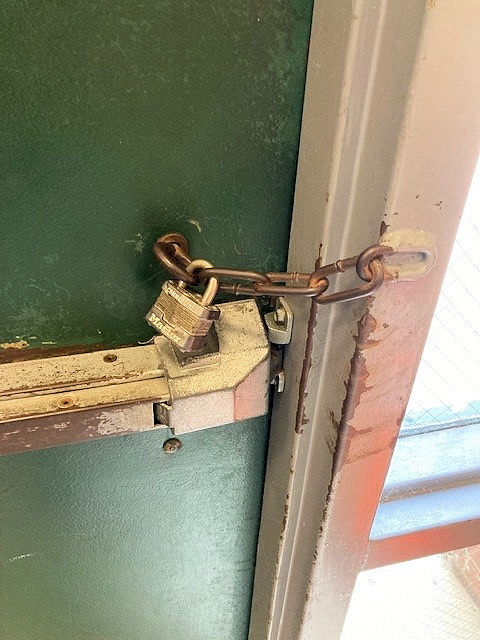
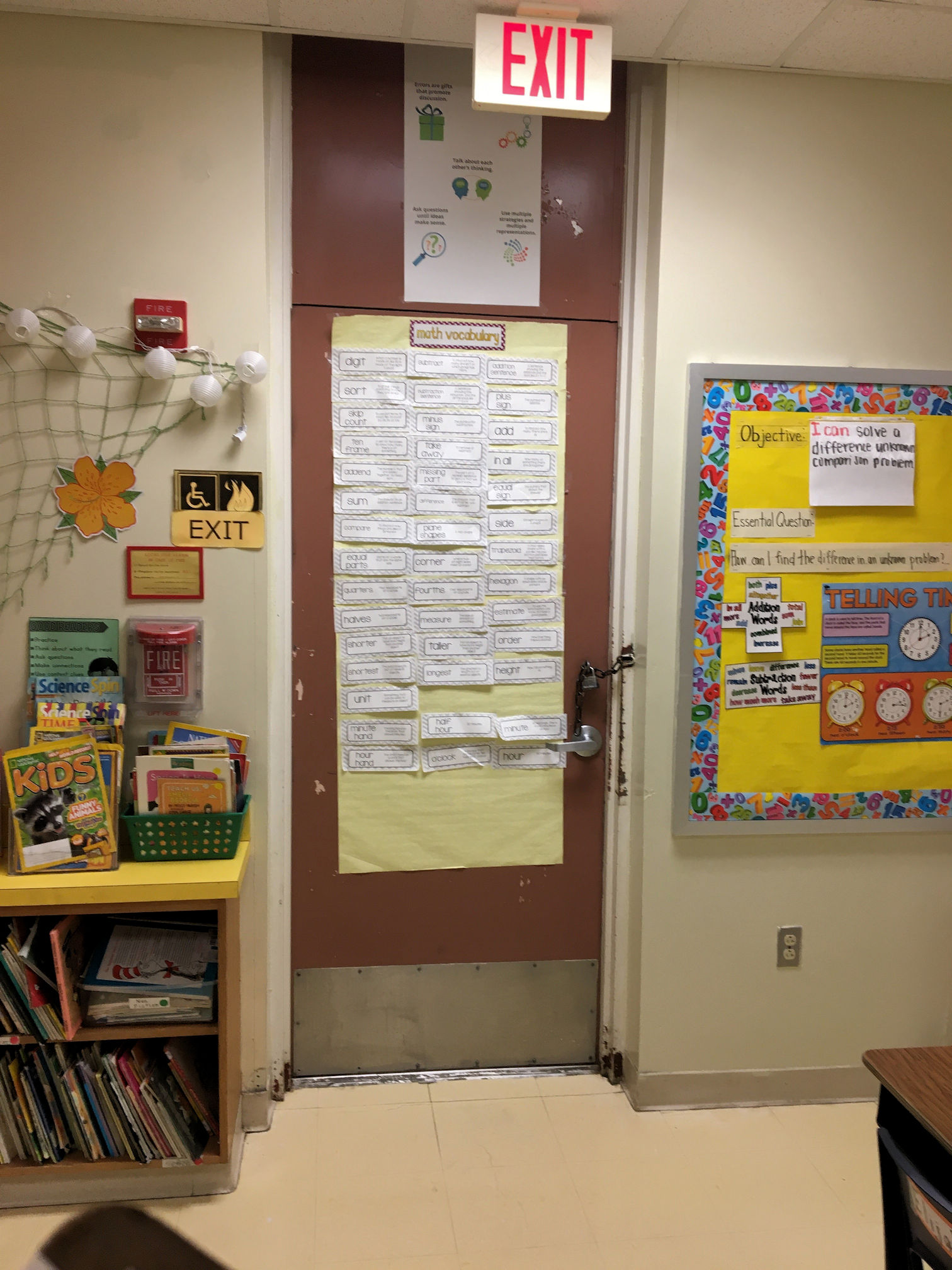


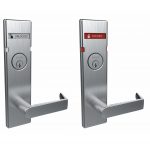
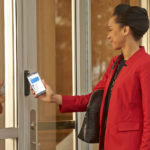
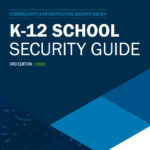
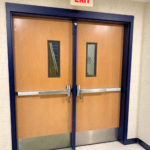




Very good code presentation.
It is bad enough with the slide on door restraints/ bars.
Sometimes those do not get removed, when the building is opened up. Just ask a principal, when I dumped a few on the main office counter, when I removed them from a few doors, After telling him a few times they cannot be in place when the building is occupied.
He was not happy. Lucky I did not have to stay after school.
I would agree under the “I codes” doors cannot be padlocked, at anytime.
As you say, you never know who might have to go into the building after hours,, And may need a way to get out, other than the way they came in.
I can’t see a good reason for allowing this, even with the allowance for 10 people or less to be considered unoccupied. How would anyone know when the 11th person comes in? How would you manage unlocking padlocks and removing chains? Would you then go back and resecure these when you are back down under the allowable threshhold? This is an opportunity for a solution to be sure!
I would agree that under the I-codes, doors cannot be padlocked at anytime.
While there may be differentiation in the LSC, as to whether or not the building is occupied, this could be a dynamic situation, which ultimately, cannot be controlled.
Would the unoccupied status include periods when Building Service Professionals are cleaning, waxing floors, emptying trash? In most schools, after 5 or 6 in the evening, the only people in the school might be these one or two service workers. If one were to say the building was unoccupied, how would they exit if perhaps a fire started on one end of the floor that had exits locked for their only safe path of egress….
Not to mention that one stair or back hallway that never gets used, it would likely stay chain and padlocked.
Hi Darrell –
Here is what NFPA considers occupied:
7.2.1.1.3.1 For the purposes of Section 7.2, a building shall be considered to be occupied at any time it meets any of the following criteria:
(1) It is open for general occupancy.
(2) It is open to the public.
(3) It is occupied by more than 10 persons.
What you are describing would likely be considered unoccupied, but each worker would need to have the keys to unlock the key-operated locks, AND…this would only apply in locations where they I-Codes have not been adopted.
– Lori
Another good example is CRIME! What if a criminal were to break into your building, begin to vandalize it, start a fire in a waste basket, etc. If things got out of control and they were trapped without a way to exit, I’m sure there is more than one savvy lawyer out there who could find the building owner at fault.
Not trying to excuse the crime or the criminal, but negligence and culpability are strong arguments when it comes to things like this.
why? what is wrong with the existing locks/exit devices? chains should never be used.
I agree with you Alex, but it’s a question that has come up SO MANY TIMES.
– Lori
Thank you Alex! My thoughts exactly. The padlocks aren’t stopping a criminal from breaking a window to enter. They stop people from exiting and that’s always a problem.
Isn’t the person locking the door occupying the building?
Yes, but it wouldn’t meet NFPA’s definition of occupied if there was 1 custodian in the building.
– Lori
The simple answer to the AHJ’s question is no. None of the codes discussed above grant any type of permission for these types of field modifications to the means of egress.
The topics of locks, locking, and special locking arrangements are thoroughly covered creating an expectation of what is and what is not permitted in the means of egress.
This is a classic example of the never ending push/pull between Life Safety and Security. By even considering something like this someone has perceived a need to keep unwanted people out of the building and has placed that need way above the duty to protect the life safety of the normal building occupants which is shortsighted and reckless because of the potential lethal consequences. Let’s face it, experienced professionals are not developing, recommending, or approving these types of home remedy solutions.
Sometimes these types of arguments try to shift away from the real danger and focus solely on the issue of “but what about when the building is unoccupied”. The sage AHJ doesn’t allow the discussion to go there and keeps the focus on should these devices ever be permitted in an occupied building, what risk do they pose to the normal building occupants from normal use, unforeseen use, failures, maintenance/breakage, etc.
Thanks Larry! I always appreciate your insight!
– Lori
We can go back as far as a few days ago, to another idighardware post, to see what happens when a “temporary” solution is installed – https://idighardware.com/2022/02/ww-covid-precautions/
Exactly!
There is the forgotten IFC
That could help
1031.2 Reliability
Required exit accesses, exits and exit discharges shall be continuously maintained free from obstructions or impediments to full instant use in the case of fire or other emergency where the building area served by the means of egress is occupied. An exit or exit passageway shall not be used for any purpose that interferes with a means of egress.
1031.2.1 Security Devices and Egress Locks
Security devices affecting means of egress shall be subject to approval of the fire code official. Security devices and locking arrangements in the means of egress that restrict, control, or delay egress shall be installed and maintained as required by this chapter.
Thanks Charles!
– Lori
The missing point of this discussion is the security of the building. That is the reason why key operated locks are allowed. The simple fact is schools and many buildings that are unoccupied, are at a high risk of break in because most exit devices are not designed for security.
Exit devices are terrific, for fire and life safety, but especially on hollow metal doors, are NOT secure.
The occupied vs. un-occupied situation is allowed in both the building and fire codes. And the wording of the code says you can lock them when un-occupied.
I agree the miss-use of padlocks often happens. But until the doors can be secured better with exit hardware, this will happen. Unless hardware spec writers, AJHJ’s, door manufactures and hardware manufactures would all assume liability for the cost of the break-ins, we should assume that locking from the inside when un-occupied will continue.
I have to disagree with this statement. Doors can be secured very well with panic devices. The VD 99xp for example can withstand >2,000 # in a
pull test. If you put any of the upper end Rim Exits on a door (use a mullion on pairs) there should be no need to use a padlock for security IMO. This is assuming that the door and frame is reinforced correctly. Another, safer way to do this if the exit device cannot withstand an intrusion on it’s own, is with a classroom deadbolt requiring locking from the exterior. Lori, does Allegion have any data on gaining access through a door secured with a padlock vs deadbolt vs exit device?
Hi Wes –
I’m not sure about the padlock because there are so many variables. But the BHMA standards include requirements for deadbolts and panic hardware, and our hardware meets or exceeds those requirements.
– Lori